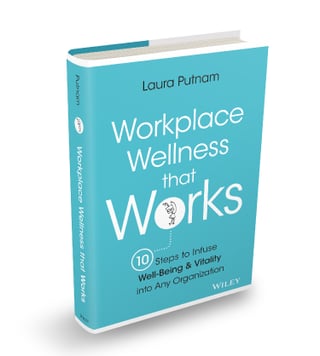.png?width=1024&name=laura%20healthcare%20(1).png)
In case you haven’t heard, corporate titans Warren Buffet, Jamie Dimon and Jeff Bezos are teaming up to “fix healthcare.” Great goal, if you consider that nearly 20% of our current GDP goes toward healthcare – wreaking havoc on every organization’s bottom line. As Buffet describes it, “Medical costs are the tapeworm of American economic competitiveness.”
While there are a lot of dimensions to “fixing healthcare” – things like increasing transparency, bringing down overpriced medical services, opening provider and insurance markets, strengthening the patient experience, improving access to primary care – the biggest piece in this vexing puzzle is just plain getting people healthier. As Gary Claxton, vice president of the Kaiser Family Foundation explains, “A lot of the money is spent on very ill people.”
So, let’s break this down. Most ill people in the US suffer from chronic conditions and disease, like heart disease, diabetes, cancer, arthritis, and obesity. These, in turn, reportedly account for a whopping 86% of our total healthcare spend.
Meanwhile, these diseases and conditions are largely driven by lifestyle, meaning that most could be prevented, and in some cases, even reversed. Therefore, we could effectively “solve” the healthcare crisis if we just got people to adopt healthier habits: exercise more, eat more veggies, quit smoking, get enough rest, practice mindfulness, build social support, and save for retirement (you know, the stuff we already know we “should” be doing).
A logical place to address this lifestyle component is in the workplace, which brings us to the topic at hand: workplace wellness. If you consider that the workplace is where most adults are spending their time, workplace wellness is a great idea – and an essential piece to fixing healthcare. As author of Workplace Wellness That Works and CEO of Motion Infusion, a well-being provider, I am a big fan of promoting well-being at work. If you are too, you can join me in San Diego for a training workshop from March 26th-27th to learn more about my 10 steps for effective wellness programs!
Just because wellness programs are a good idea, it doesn’t mean we’re doing it well. Evidence suggests that we’re not doing such a great job if you consider that as many as 80% of the people we’re trying to reach are opting out of these workplace wellness programs.
Simultaneously in the news, a recent University of Illinois study is generating headlines like Bloomberg’s “Workplace wellness programs really don’t work.” The truth is if workplace wellness is done well, it can lead to positive results for both employees and the bottom line. Several studies, for example, have demonstrated a correlation between having a comprehensive well-being program in place and performing well in the stock market.
So, the real question is: How do we take a really great idea (workplace wellness) and do it better so that we really can start to get a fair swing at “fixing healthcare?”
This is exactly what my book Workplace Wellness That Works tackles. I offer 10 steps to improve upon how we’re currently designing and delivering workplace wellness, and on March 26 and 27, I’ll be delivering a two-day intensive training session that addresses each of these steps in depth.
Here’s a brief recap of the 10 steps you can follow to either build a wellness program from the ground up or refresh one that’s already in place:

The first step is to shift your mind-set from starting a workplace wellness program to starting a movement. Programs don’t move people; movements do. This means that you’ll need to recast yourself as an agent of change.
“Health” doesn’t motivate most; quality of life does. So, you’ll need to shift the conversation from just physical health to one about well-being and living a life of vitality, addressing the multiple dimensions of well-being, such as mental, emotional, social, financial, career and community. Evidence suggests that these elements are just as important as exercise and diet when it comes to living a healthy, happy life.
You’ll need to examine the larger workplace culture to identify elements that are likely to support your efforts, as well as elements that might undermine your movement. Culture is what’s going to support or compromise any well-intended workplace wellness program.
Most wellness initiatives start with screenings and invasive “health risk assessments.” Not too inspiring if you’re trying to start a movement! Instead, you can build optimism into your movement by applying a strengths-based approach. Help people to focus first on what they’re doing right, as opposed to just uncovering risks and highlighting what they’re doing wrong.
Workplace wellness has been silo-ed. To build your movement, you need to move beyond the ordinary wellness committee and benefits department to create an interdisciplinary “da Vinci” team, bringing together unlikely partners from all different departments.
Rather than creating stand-alone wellness programs, look for ways to “sneak” well-being into other initiatives. Some top stealth opportunities for embedded wellness include leadership development, management training, and safety programs.
Incentives and penalties have become a fixture in workplace wellness. Meanwhile, all of the research shows that lasting change only happens as a result of intrinsic motivation – or that which comes from within. Your task will be to create the conditions in which employees are more likely to motivate themselves.
Change the environment and shape the culture to make well-being the “new normal.” Identifying the challenges in changing your company culture requires some self-awareness from leadership. Creating wellness norms are powerful when initiated from both the top (senior leaders) and from the middle (managers). Your task will be to activate leaders on all levels, especially managers, to become “multipliers of well-being.”
Following the lead of companies like IDEO and Google, foster an experimental, learning-based approach to your movement.
Share best practices across national boundaries. Make your movement an international one!
Successful workplace wellness programs thrive off of happy company cultures. Read why:
